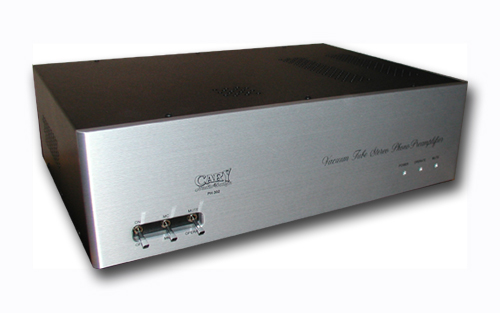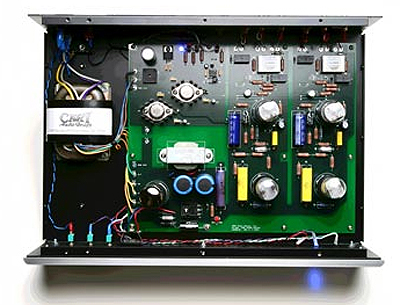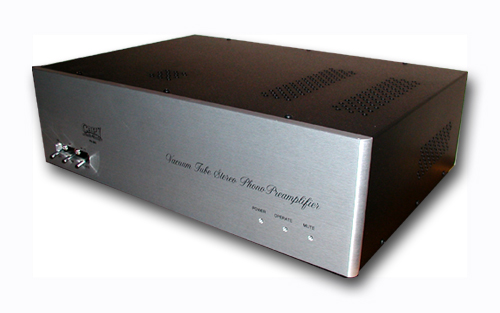You are reading the older HTML site
Positive Feedback ISSUE
19
may/june 2005
cary audio
PH-302 phono stage
as reviewed by John Zurek

|
JOHN ZUREK'S SYSTEM LOUDSPEAKERS ELECTRONICS SOURCES CABLES ACCESSORIES
|
Please note that this is PFO's second look at the Cary 302 phono preamp. For Bob Levi's excellent report, go to https://positive-feedback.com/Issue13/caryMr. 302.htm. Although not well known for phono preamps, Cary has built a few in the past, some stand-alone, others as part of full-function preamps. They tend to be considered good, but the Cary record on phono preamps is about to change—Mr. 302 is here. The 302 is a one-box phono stage, in a large box for a preamp. It delivers gain via tubes and transformers. The tube complement includes two 6SL7s in the head amp, two 6SL7s for the RIAA EQ and amp gain stage, and one 5AR4 for rectification. Valves and vinyl belong together.
The 302 accepts both moving-coil and moving-magnet cartridges. Unusually, it has no provision for adjusting the impedance load for different cartridges. It includes separate step-up transformers for MC cartridges, and separate inputs for MC and MM cartridges. The MM input is optimized for a 47K-ohm load, and the MC input is optimized for 100 ohms. I was able to use the 302 with three different turntables: my trusty VPI HW-19jr (BTW, the "jr" stands for junior, not "just right"), the Opera LP-1 (see Opera and more Opera for reviews on this table), and my newest love, the VPI Scoutmaster. I mounted my low-output Benz Glider MC on all three tables. When Mr. 302 got into the game, it was the best I'd ever heard these three decks sound in my room, without a doubt.

My review sample came with a brushed stainless steel faceplate. It looked nice and exuded quality, but I found its appearance to be nothing special. It is easy to use, as controls are kept to a minimum. What do you get? A power switch, MC/MM switch, mute switch, inputs for MC and MM, outputs to preamp/amp, and a grounding post. Minimal. So is the noise—minimal, that is. I could barely detect the tube rush with my ear next to a tweeter.
My first impression of the 302 was that it had a slightly warm but very neutral character. Bear in mind that I had been listening to my overachieving (but not cube-shaped) Black Cube for several years, and its solid-state signature had been imprinted on what is left of my audio brain. Fortunately, the review sample had been broken in by Bob Levi, so I was confident that its sonic signature would not change greatly. On to the listening.
All the records I listened to are part of my original collection, the youngest being Steely Dan's Gaucho at 25 years, the oldest Crosby, Stills, and Nash at 36! First up was the title track of Gaucho. The leading edges of notes, from the very soft to the loudest, were all a little sharper (in a good way) and cleaner than ever. I had never heard so much information extracted from those old grooves. The midrange was especially textured, coherent, and believable. This was by far the best I'd heard this tune sound in my room. After it was over, I immediately listened to the same track on CD, on my Cary 303/200. Yow! Digital sucks. Donald Fagen sounded like a grey ghost in comparison to the analog rendition, and the instruments sounded like they were being played through an AM radio.
Next up was "Your Move," from The Yes Album. Mr. 302 really glowed here, and established its membership in the upper echelon of analog rigs. The gentle vocal harmonies had a neutral balance, with fine low-level detail. I have never really liked Jon Anderson's falsetto-like vocals, but the coherence of the 302 allowed his voice and the group's instruments to really sing. I had always been aware of the presence of the recorder, but its role was never quite as apparent before Mr. 302 came along.
Last was "Guinevere," from Crosby Stills and Nash. Ohhh myyy, the air and detail, with images cushioned in smooth texture. It was enough to make me cry. The sustain of the plucked harmonics on the Martin acoustic guitars lasted forever. The exotic blend of the three voices was addicting. I listened to this cut five times, couldn't get enough of it. There's a magical vibe to this record that has never been recreated. Right on.
Over several months of listening to the Cary 302, I got used to it (or did it get used to me?), and my impression of its warm signature faded. What else changed when I compared it to my former reference? Everything. Low-level detail. Macro- and micro-dynamics. Harmonic detail. The texture of each and every instrument, including voice. Neutrality. Imaging and soundstage. Most important was the ahhh factor, with the 302's simply gorgeous tone, especially in the crucial midrange. For four times the price of my overachieving Black Cube, the Mr. 302 should sound better in every respect, and it did. What made the 302 worth all those drachmas was its ability to totally integrate all its wonderful qualities into a cohesive package. The more you listen to it, the more you'll like. The 302 absolutely excels at communicating the soul of the music.
Problems? Nits? The unit worked perfectly for the many months I had it. Its controls, fit'n'finish, and useability are perfect. I would like to see some adjustment for different types of MM and MC cartridges. Adding those could make this the phono preamp to own. At $2500, Mr. 302 is not cheap, but it plays in the big leagues and doesn't need steroids. It competes favorably with many preamps that are much pricier. It may actually be the biggest bargain among top-shelf phono stages. It has soul. Why Mr. 302? Simple—it's a term of respect. Highly recommended. John Zurek

302 phono-stage
Retail: $2500
Cary Audio Design
TEL: 919. 481. 4494
web address: www.caryaudio.com
e-mail: [email protected]
